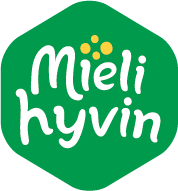

Frequently Asked Questions
Here we have answered some of the questions we are frequently asked.
We hope you will find what you are looking for, if not send us a message.
Mielihyvin Honey is great and excellent. Thank you for that! But how it stays flowing?
We knead the honey slowly and carefully during its natural crystallization, making the texture soft and digestible in the mouth. The fine crystallinity gives the honey a beautiful pearly light color. Mielihyvin Honey stays soft and supple until the best before day and does not harden in the package. Mielihyvin Honey retains all the good qualities of honey because it is not heated to flow.
The tube honey is really convenient and the honey very good, but the honey flows into the cap. Do you have any suggestions to fix this?
There is no actual lock at the mouth of the squeezable tube, i.e. the honey flows out of the tube on its own if the cap is left a little cracked. In this case, the cap is at some point incompletely twisted or has not been properly threaded, causing the honey to drain and mess up the cap. After use, the tube should be turned up and the cap screwed on properly before being placed on the table. We have made an instructional video on using a honey tube, it can be found here
https://www.youtube.com/watch?v=qDF0i-B0LyE
Where can I get Mielihyvin Honey?
You can find our honey in Finland in retail stores of all sizes, such as S-Markets and Prismas, K-Markets, K-Supermarkets and Citymarkets. In addition, our honey is sold in Stockmann Delicacies as well as in Ruohonjuuri stores and in many local food and health food stores.
If the products are not in the selections, make a request to the merchant to have the products in the selections.
I would like to know if Mielihyvin Honey is heated?
Mielihyvin Honey is not heat treated to about + 40 degrees warmer. We centrifuge the honey in August and store it in barrels. We pack honey in consumer packaging all year round and then the honey needs to be heated up a bit to get it sifted from the waxy crumbs. After sieving, the honey is allowed to crystallize in a tank where it is stirred several times a day. This kneading causes our honey to flow and soft, and it no longer hardens. The honey is usually heat-treated or heated when it is desired to keep it flowable, translucent and clear for as long as possible, in which case the honey is heated to about 75 degrees. This kind of running honey has its own friends, but we have chosen a more gentle treatment for the honey. On the store shelf, these honeys are distinguished by the fact that they are translucent, syrupy.
Why do you use a plastic tube to pack organic honey?
The compressible tube package is a very convenient and handy package. It is easy to dispense honey from a tube on top of natural yoghurt, berries or gourmet cheese. This is why customers like it very much and that is why we pack it in a tube. However, we plan to replace the plastic material with bio-based plastic as soon as possible. We would have already changed the material of the new Mielihyvin Tubes to bio-based sugar cane plastic, but unfortunately our packaging supplier could not yet guarantee the suitability of this material for food.
Is Mielihyvin Organic Honey 100% honey without any other ingredients?
Honey is a natural product collected and made from honey by bee plants, to which no substances have been added or removed. Mielihyvin Honey is a 100% natural product.
Why should honey not be given to children under 1- year of age?
Honey is an unheated live food, so it may contain spores of the bacterium Clostridium botulinum. These spores are relatively common in, for example, soil, waterways and dust. As a result, spores are occasionally found in, for example, honey, herbs and vegetables. In infants, spores that enter the gastrointestinal tract can cause the disease because the normal flora of the digestive tract and intestines has not yet developed. For this reason, honey packs have a warning label: Only for people over 1 year of age.
For children and adults over the age of one, the spores of Clostridium botulinum are harmless and they can use honey as a sweetener on a daily basis. A pregnant woman or a breastfeeding mother can also use honey without any worries, as any spores do not pass through the mother or breast milk to the baby.
Why are pollinators so important?
Bees, bumblebees and many other insects are vital aids in food production. By improving the living conditions of pollinators, each of us can contribute to their well-being. The more diverse the environment, the more it provides both nesting sites and food for pollinators. Early spring and fall summer in particular are critical times for pollinators and therefore the plants that bloom during these times are the best for pollinators. Willows in particular, for example, a strip that grows into a beautiful large tree is a tree that every porpoise would plant. Even the smaller willows are great plants for pollinators, but many of them deteriorate over the years and need to be cut down in between. There are a lot of plants favorable to pollinators, the most important thing is probably that there is a wide variety of plants, trees and shrubs growing at all, the short-cut grass field is a desert for pollinators.
